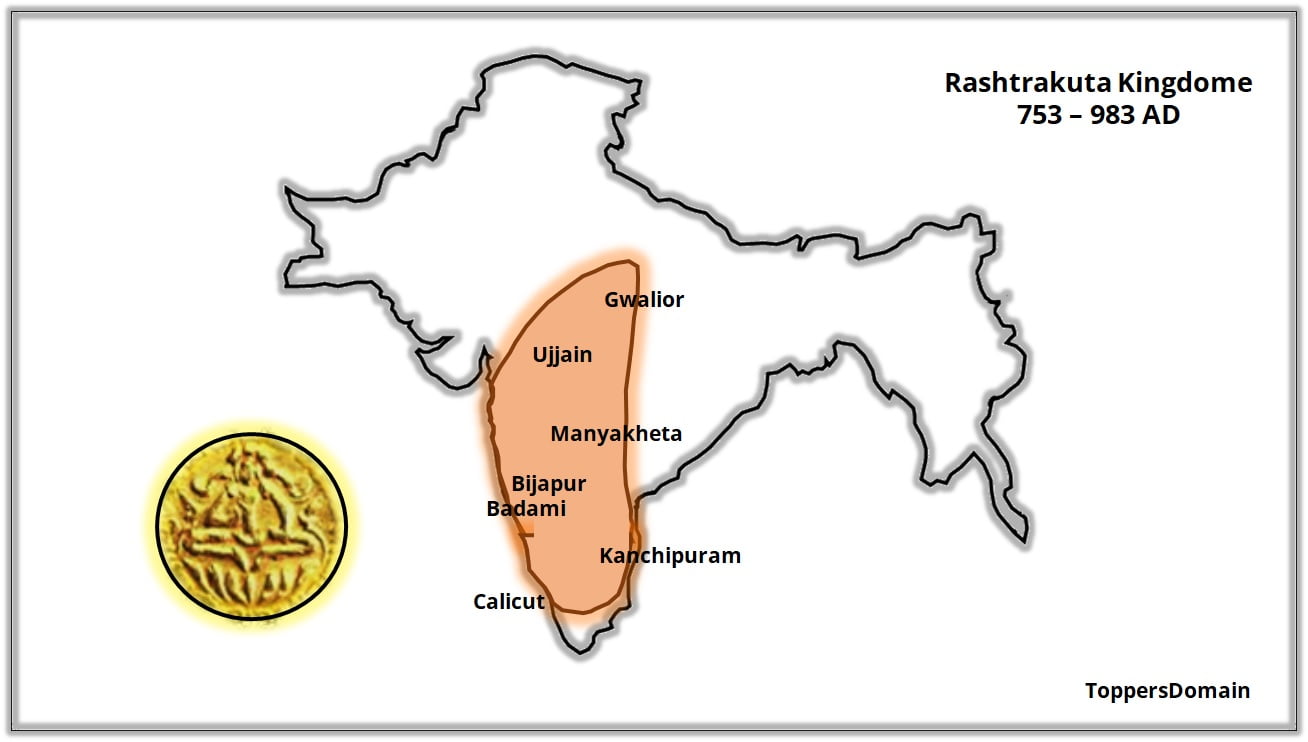Rashtakutas
History
- Language
Index
The Rashtrakutas, a prominent dynasty that reigned from the 6th to the 10th century CE, left an indelible mark on the Indian subcontinent. Their kingdom spanned across present-day southern and central India, including the regions of Maharashtra, Karnataka, Andhra Pradesh, and Tamil Nadu. The Rashtrakutas held significant political, cultural, and economic influence during their reign, making them a force to be reckoned with in medieval India.
Introduction
The Rashtrakutas emerged as a dominant power in the Deccan region, known for their military prowess and efficient administration. With Manyakheta (present-day Malkhed) as their capital, they expanded their boundaries through military conquests and strategic alliances. Their empire rivaled the power of the northern dynasties, establishing them as a formidable force in Indian history.
Emergence and Dominance
The Rashtrakutas rose to power in the Deccan region, and their military strength and administrative efficiency allowed them to dominate the political landscape. Manyakheta served as the capital where the Rashtrakutas wielded their power and consolidated their rule. Their efficient administration and strategic decisions laid the foundation for their dominance.
Expansion and Empire
The Rashtrakutas expanded their kingdom through military conquests and diplomatic alliances. Their territorial control expanded to encompass vast regions, challenging the power of the northern dynasties. The Rashtrakutas engaged in conflicts with dynasties such as the Chalukyas, Pallavas, and the Pratiharas, but they also formed alliances with them at different points in history, showcasing their diplomatic acumen.
Important Rashtrakuta Rulers
Several influential rulers played crucial roles in shaping the destiny of the Rashtrakuta dynasty. Dantidurga, the founder of the dynasty, established Manyakheta as the capital and expanded his kingdom through conquests. Krishna I, known for his military campaigns, defeated the powerful Chalukya dynasty and extended the influence of the Rashtrakutas in the Deccan region. Govinda III, considered one of the greatest Rashtrakuta rulers, reached the zenith of the empire by defeating the Gurjara-Pratihara dynasty in northern India and controlling a vast territory. Amoghavarsha I, a patron of arts and literature, wrote the significant Kannada literary work called Kavirajamarga. He promoted religious harmony and made Manyakheta a center of cultural excellence.
Political and Cultural Legacy
The Rashtrakutas left an enduring legacy in medieval India's political and cultural landscape. Their empire encompassed a vast territory and fostered cultural diversity. The architectural marvels, inscriptions, and literary contributions they left behind serve as a testament to their grandeur.
Patronage of Art, Literature, and Architecture
The Rashtrakutas were patrons of art, literature, and architecture. Their court thrived with scholars, poets, and philosophers who contributed to the rich literary tradition of the time. They fostered a cultural environment that encouraged the development of Sanskrit literature. The fusion of ideas and t raditions resulted in a vibrant cultural tapestry.
Religious Tolerance and Diversity
The Rashtrakuta Kingdom boasted a diverse population with people from various ethnic and linguistic backgrounds. The rulers encouraged the assimilation of different cultural influences, fostering an environment of tolerance. Jainism and Hinduism were the predominant religions, and the Rashtrakutas were known for their acceptance and respect for different faiths.
Governance and Administrative System
The Rashtrakutas followed a centralized administrative system that allowed them to effectively govern their vast empire. They divided the kingdom into rashtras, which were further divided into vishayas or districts. Each vishaya was under the authority of a vishayapati responsible for maintaining law and order, collecting taxes, and ensuring the well-being of the people.
Economy and Trade
The economy of the Rashtrakuta Kingdom thrived primarily on agriculture. They implemented measures to improve agricultural practices, such as constructing irrigation systems and promoting the cultivation of cash crops. Trade and commerce flourished under their rule, with significant maritime connections with regions like the Arabian Peninsula, East Africa, and Southeast Asia. Ports like Kalyan, Mangalore, and Chaul played vital roles in trade.
Art and Architecture
Art and architecture reached new heights during the Rashtrakuta period. The Rashtrakutas built magnificent temples that reflected their religious and artistic fervor. The rock-cut caves of Ellora and Elephanta, along with the famous Kailasanatha temple at Ellora, stand as remarkable architectural achievements. These structures are adorned with intricate carvings, detailed sculptures, and exquisite craftsmanship.
Diplomacy and Conflicts
The Rashtrakutas maintained diplomatic relations with neighboring kingdoms, engaging in both conflicts and alliances. They faced sporadic conflicts with the Chalukyas, Pallavas, and the Pratiharas in the north. However, they also formed alliances with these dynasties at different points in history, showcasing their diplomatic acumen.
Conclusion :
The Rashtrakuta Kingdom's political and cultural significance cannot be overstated. Their rule over vast territories, promotion of cultural diversity, support for art, literature, and architecture, and administrative efficiency contributed to their grandeur. The Rashtrakutas left an indelible impact on the history and heritage of India.
Share
Other Topics
Unit - V


